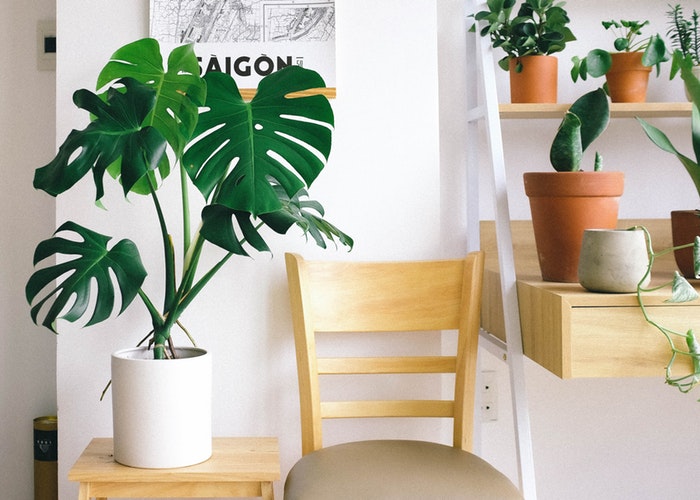Here’s Why You Keep Killing Your Houseplants (And How Not To)

If a lush foliage plant caught your eye at Trader Joe’s or you delight in the bursts of curated greenery on plant Instagram accounts, you may have considered growing a houseplant of your own.
Being a plant parent can be a precursor for greater adulting milestones down the line. You may not be ready to adopt a puppy or assume the responsibility of starting a family, but seeing your plant baby thrive under your care is truly a rewarding experience. As with any new journey, however, you’ll likely come across some (more like many) learning curves.
After being a houseplant hobbyist for over a year, I’ve learned a few common mistakes along the way. Here’s what you need to know to avoid killing your houseplants.
You’re probably overwatering.
What to do instead: Check the soil’s moisture level before watering.
Overwatering is a common culprit for struggling houseplants. Although different plants may require different care, chances are your plant doesn’t need its soil fully saturated every day. Too much water can lead to root rot which is the point of no return for many houseplants.
Instead of forcing my plants into a regimented watering schedule, I check how moist the soil is by gently sticking my finger two inches into the soil. If my finger comes out dry, I water the soil thoroughly until water comes out of the pot’s drainage hole.
Don’t like the idea of getting dirt under your fingernails? Use a chopstick to gauge the moisture instead. If soil clings onto the chopstick you probably don’t need to water the plant, but if it comes out dry it might be time to give your houseplant a drink.
Your cute, hip planters might not have adequate drainage.
What to do instead: Use a pot with drainage holes or use a nursery pot inside a decorative planter.
As a plant mom, I was enchanted by the idea of growing trendy houseplants in chic planters — of course, those planters didn’t have drainage holes at the bottom. My attempts to turn my home into a page out of a Crate & Barrel catalog led to my plant sitting in sopping wet soil because excess water escape couldn’t escape. My novice heavy-handed watering didn’t help, either.
Had my planters been fashioned with holes, I would’ve seen overflow seeping out of the bottom as a sign to stop watering. On the surface of the soil, you may see the vibrancy of the plant’s leaves fade, turn yellow, or drop off in rapid amounts, if there’s a root issue.
If you suspect your plant might have root rot, gently tip it out of its pot and inspect the roots. Healthy roots are white, firm, and may have fine root hairs as part of a robust root system. Roots that stay black after a quick rinse, feel mushy or have a bad odor are likely dead. In this case, the damage is unsalvagable. If the rot hasn’t crept up to the plant stem and there are healthy growth nodes present, you may be able to propagate the unaffected stem.
Your plants aren’t getting enough light.
What to do instead: Know the directions of your home’s natural light sources.
Proper watering is an important part of helping a houseplant thrive; sunlight is another key factor. When you bring a plant home from a nursery or big box store, you might see a care tag that says something, like “low light” or “indirect light.” This description might have you believe that your plant will live a happy life tucked in the corner of your entryway, far from a window or light source.
The reality is that plants need sunlight to photosynthesize. This process is how they make their food. A plant that is hidden in the shadows is literally starving for light. One sign that your plant is asking for more light is if it’s stretching toward the direction of natural light in your home or is looking leggy (when a plant gets long without many leaves or buds) and unruly.
Move it to a place that’s closer to a natural light source. Depending on what direction your windows face, you’ll get varying levels of light intensity thanks to the sun’s movement throughout the day. Below is a brief overview of light levels based on your window direction.
- Southern: Offers brightest light exposure throughout the day
- Eastern: Intense light in the morning, less light in the afternoon
- Western: Gentle light in the morning, intense exposure in the afternoon
- Northern: Lowest exposure throughout the day
The amount of light your plants need depends on the kind of plant you have. For example, my tropical plants, like my Philodendron and Monstera, enjoy my northwest windows with offers consistent, diffused light throughout the day. My indoor cacti, however, don’t get enough natural light from my northwest windows so I supplement their environment with artificial grow lights aimed directly at them.
The biggest lesson to avoid killing your houseplants is to not give up on them too soon. It’s easy to feel frustrated when plants don’t respond to your care in the way you expect or don’t look as flawless as they’re portrayed on social media. Remember, you and your plants don’t have to be perfect. Nurturing happy houseplants just takes observation and patience.
Jennifer is an L.A.-based writer and editor who covers topics like travel rewards, personal finance, and lifestyle. She’s been featured on Business Insider, Forbes, Nerdwallet and U.S. News. When she’s not writing, you can find her caring for her collection of more than 100 houseplants or sipping on her fifth coffee of the day.
Image via Pexels
Like this story? Follow The Financial Diet on Facebook, Instagram, and Twitter for daily tips and inspiration, and sign up for our email newsletter here.


